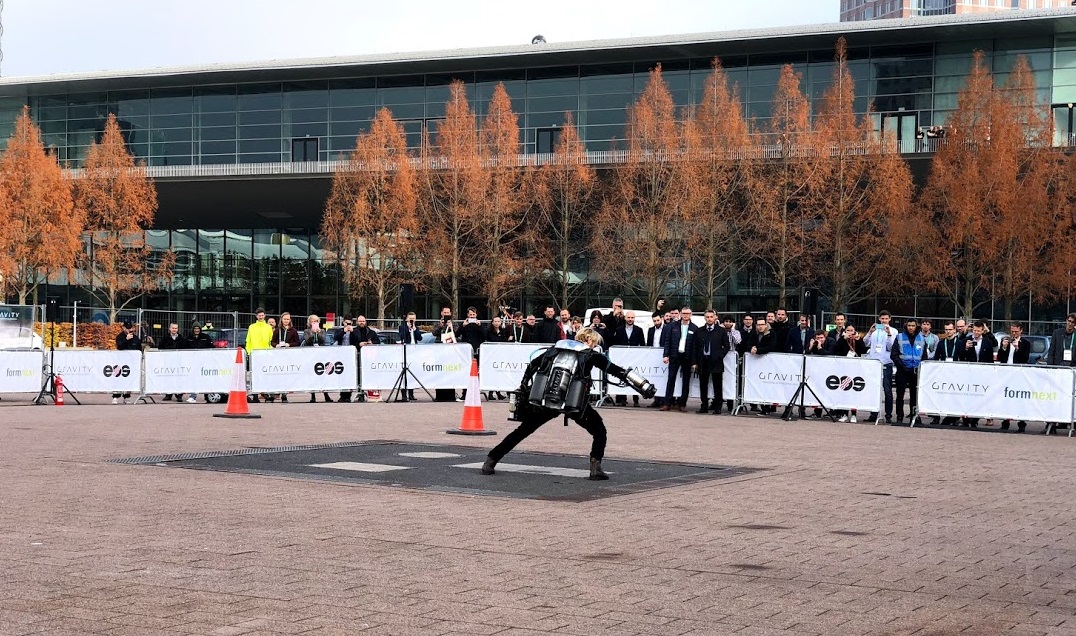![Gravity Industries’ jetpack demo at formnext 2018 [Image: Fabbaloo]](https://fabbaloo.com/wp-content/uploads/2020/05/IMG_4985_img_5eb0a2762428a.jpg)
When is the right time to introduce an innovative solution?
That’s the billion-dollar question, and additive manufacturing is working on a series of answers. This past week’s formnext highlighted a new series of rapidly materializing realities in manufacturing — and brought to light a pertinent point shared in common between industry and comedy: It’s all in the timing.
This point was best driven home in three very different conversations with Lee-Bath Nelson, Co-Founder and VP of Marketing and Business Development at LEO Lane; David Burns, Principal and Founder at Global Business Advisory Services, Senior Advisor with the Association for Manufacturing Technology, and Co-Founder of ExOne; and Dr. Angelo Grubisic, Head of Flight Training at Gravity Industries.
The three, representing three nationalities and three diverse points of participation in the additive manufacturing industry, all turned to the importance of timing in our conversations. When is the right time to launch a new technology — and when does a failure to launch not signify broader failure?
“I think daring is really important,” Nelson told me as we discussed the career path that led to the founding of Israel-based digital inventory specialist LEO Lane. “The first venture firm I was with invested in Objet; I have been watching this field for almost 20 years, and I don’t need to tell you how it’s changed. That’s an opportunity: identifying challenges that can be solved with software — and I’m a software gal — to understand software and business. And good investors understand: you have to start a startup before a problem becomes acute.”
![[Image: Fabbaloo]](https://fabbaloo.com/wp-content/uploads/2020/05/IMG_20181114_155024_img_5eb0a276bafb3.jpg)
Identifying that exact junction between identifying a challenge and providing a market solution addressing it provides a timely resource that the industry needs — and is done best prior to any ‘explosive’ negative arising from that problem. Understanding the changing landscape of agile manufacturing, for example, leads to identifying the protection of intellectual property as a major challenge that will need to be addressed. Done in reaction to a major IP crisis, such a solution could easily appear as ‘too little, too late’ and undermine the integrity of any viable solution brought to market after the fact.
Regarding timing in industry, Burns noted that when founding ExOne in 2005, his long-standing background in manufacturing led him to see the move as a next step toward needed market solutions.
“I see the evolution from PLC to CNC to integrated digital processes as moving up the curve; every big step implies trust, and the ceiling on potential outcomes is higher. Every one of these so-called ‘revolutions’ I don’t see as a revolution, but a next step on this curve,” he explained. “I’ve seen a lot of successes and a lot of failures in this business, and ultimately either way it’s a product of R&D dollars.”
![David Burns [Image: Fabbaloo]](https://fabbaloo.com/wp-content/uploads/2020/05/IMG_20181115_164133_img_5eb0a27777d8c.jpg)
The move toward digital manufacturing is, he noted, growing into a dynamic digital age reaching beyond something of a plateau.
That growth is, of course, not always the easiest to see through, and all new technologies and innovative advances will be struck by some adversity in implementation.
On the Wednesday of the show, Gravity Industries set off to demonstrate its jetpack innovation (brought to life with the help of 3D printing from EOS) — but the demo didn’t exactly go off as planned, as the “real life Iron Man” stayed grounded due to a faulty second engine. Instead, the gathered crowds watched Grubisic propel himself in a circle with one functional engine thrusting enough to showcase its power (at about 1:30 below).
When we sat down later that afternoon to talk about how 3D printing is helping to enable human flight, most of our chat was centered around the technologies helping to meet needs and standards. Describing 3D printing as “a light that will continue to shine brighter,” Grubisic graciously responded to my asking about his feelings on the day’s demo that didn’t get off the ground.
“It’s still a pioneering technology; we’re not churning out thousands of suits, but are still developing the best. We’re operating on the edge of developing parameters, which can cause an issue like today. It’s part of the process, the transition between development and product,” he explained pragmatically. “We’re obviously disappointed; no one likes to have a problem or a failure. But it’s aviation, and aviation always has failure. If the worst that can happen is a small tumble, it’s still a good day. There is always a line between risk and success.”
![Gravity Industries and 3D printed jetpack components at formnext 2018 [Image: Fabbaloo]](https://fabbaloo.com/wp-content/uploads/2020/05/IMG_20181114_150140_img_5eb0a278037b4.jpg)
That line between risk and success is a fine one, especially in aviation — and many of the other verticals acting as early adopters for additive manufacturing technologies, such as automotive and medical. As 3D printing continues to enable new solutions, and to create such solutions before any of the problems reach a critical stage or the failures endured are more mission-critical, development will remain focused on best-fit advances in the best possible timelines.
My high school Spanish teacher memorably ended each class with, “Have the best of all possible days!” The cheery message resounds through this industry now, as we might perhaps say each day, “Create the best of all possible solutions today!”
Well — today when it’s the right time, and tomorrow when it needs to percolate a bit longer; innovation is all in the timing, after all.












1 comment
Comments are closed.